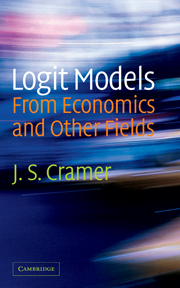Book contents
- Frontmatter
- Contents
- List of figures
- List of tables
- Preface
- 1 Introduction
- 2 The binary model
- 3 Maximum likelihood estimation of the binary logit model
- 4 Some statistical tests and measures of fit
- 5 Outliers, misclassification of outcomes, and omitted variables
- 6 Analyses of separate samples
- 7 The standard multinomial logit model
- 8 Discrete choice or random utility models
- 9 The origins and development of the logit model
- Bibliography
- Index of authors
- Index of subjects
3 - Maximum likelihood estimation of the binary logit model
Published online by Cambridge University Press: 11 January 2010
- Frontmatter
- Contents
- List of figures
- List of tables
- Preface
- 1 Introduction
- 2 The binary model
- 3 Maximum likelihood estimation of the binary logit model
- 4 Some statistical tests and measures of fit
- 5 Outliers, misclassification of outcomes, and omitted variables
- 6 Analyses of separate samples
- 7 The standard multinomial logit model
- 8 Discrete choice or random utility models
- 9 The origins and development of the logit model
- Bibliography
- Index of authors
- Index of subjects
Summary
This chapter deals with the elements of maximum likelihood estimation and with their application to the binary logit model, as practised in the logit routines of program packages. It explains the technique so that the reader can understand what goes on, and it pays particular attention to the properties of the resulting estimates that will be used in later chapters. A detailed example follows.
Principles of maximum likelihood estimation
Probability models are often estimated from survey data, which provide samples of several hundreds or even thousands of independent observations with a wide range of variation of the regressor variables. Since the advent of modern computing the preferred technique of estimation is the method of maximum likelihood. This permits the estimation of the parameters of almost any specification of the probability function. It yields estimates that are consistent and asymptotically efficient, together with estimates of their asymptotic covariance matrix and hence of the (asymptotic) standard errors of the estimates. Many statistical program packages provide ready routines for the maximum likelihood estimation of logit and probit models (see Section 1.3), but even when these are used it can be helpful to understand the first principles of the method. The present section shows how it works for binary probability models, without going into the underlying theory.
- Type
- Chapter
- Information
- Logit Models from Economics and Other Fields , pp. 33 - 55Publisher: Cambridge University PressPrint publication year: 2003



